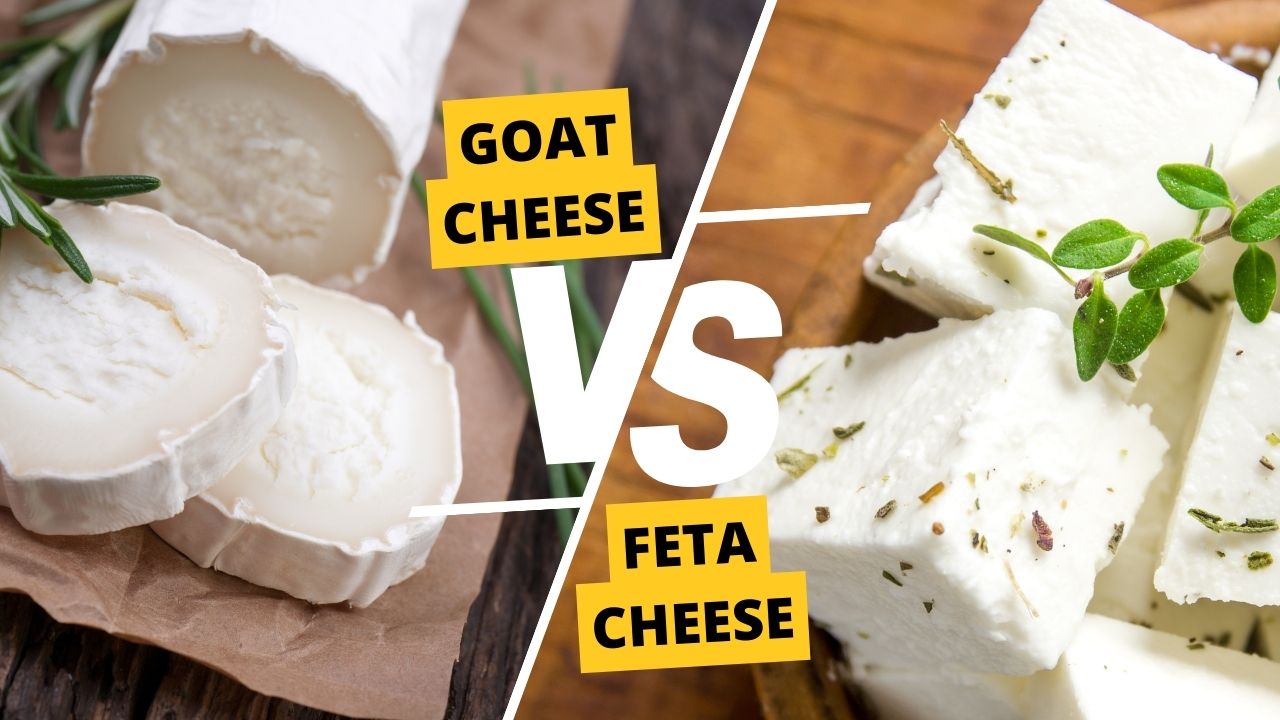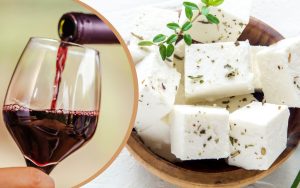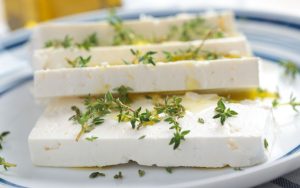If you’re a cheese lover, you’ve probably come across the debate of feta cheese versus goat cheese at some point. Both these cheeses are known for their crumbly texture and distinct flavors, but they have their unique characteristics that set them apart. In this blog post, we will delve into the qualities, differences, and similarities of feta cheese and goat cheese, helping you make an informed decision the next time you’re faced with this delicious dilemma.

Exploring Feta Cheese
Feta cheese, with its rich history and distinct characteristics, has become a beloved ingredient in many culinary traditions. Originating in Greece, feta cheese boasts a tangy and salty flavor profile that sets it apart. Its crumbly texture adds a delightful element to various dishes, making it a versatile cheese that can be incorporated into countless recipes.
A Taste of Greek Heritage
Feta cheese holds a special place in Greek cuisine, where it has been enjoyed for centuries. Its roots trace back to ancient times, and it has become an integral part of traditional Greek dishes. One bite of feta cheese transports you to the sun-drenched Mediterranean, with its tanginess reminiscent of the salty sea breeze that kisses the Greek islands.
Unique Qualities and Culinary Applications
What sets feta cheese apart is not only its flavor but also its crumbly texture. This makes it an excellent choice for crumbling over salads, as it adds a delightful salty and tangy punch to fresh greens and vegetables. Feta cheese also shines in savory pastries, imparting its distinct flavor into dishes like spanakopita and tiropita.
Versatility and Global Appeal
While feta cheese is deeply rooted in Greek cuisine, its appeal extends far beyond the borders of Greece. Its tangy flavor and crumbly texture make it a versatile cheese that pairs well with various ingredients. Feta cheese can be found in dishes from around the world, such as Mediterranean-inspired wraps, sandwiches, and even pizza.
Beyond the Salad Bowl
Although feta cheese is commonly associated with salads, its uses go far beyond mere garnish. In Greek cuisine, it is often baked or grilled, taking on a creamy and slightly melted consistency that enhances its flavors. Feta cheese can also be enjoyed as a standalone appetizer when marinated in olive oil, herbs, and spices, allowing its unique taste to shine.
A Cheese with Character
Feta cheese’s tangy and salty profile can be attributed to its production process. Traditionally made from sheep’s milk, or a blend of sheep’s and goat’s milk, feta cheese undergoes a fermentation and aging process that develops its distinctive flavors. This careful craftsmanship contributes to its character and makes it a sought-after cheese worldwide.
Exploring New Frontiers
While feta cheese has a strong presence in traditional Greek cuisine, it is also a cheese that invites innovation and experimentation. Chefs and home cooks alike have taken feta cheese beyond its traditional applications, incorporating it into modern recipes such as feta-stuffed chicken breasts, roasted vegetables with crumbled feta, and even feta cheese ice cream.
Unveiling the Wonders of Goat Cheese
Goat cheese, with its creamy texture and distinctive flavors, holds a special place in the hearts of cheese enthusiasts. Made from the milk of goats, this cheese offers a unique taste that sets it apart from other varieties. Let’s delve into the world of goat cheese and uncover its wonders.
A Rich History and Global Influence
Goat cheese has a rich history that dates back thousands of years. It has been enjoyed in various cultures around the world, from Europe to the Middle East and beyond. This cheese has gained popularity for its versatility and the delightful tanginess it brings to dishes.
Creamy and Tangy Delight
One of the defining characteristics of goat cheese is its creamy and slightly tart taste. The cheese offers a pleasant tanginess that lingers on the palate, providing a refreshing and unique flavor experience. This distinctive profile makes goat cheese a favorite among those who appreciate its creamy yet tangy allure.
Culinary Versatility at Its Best
Goat cheese’s versatility shines through in its ability to complement a wide range of dishes. Its creamy texture lends itself beautifully to spreads and dips, such as goat cheese and roasted red pepper dip. It can also be crumbled over salads or used as a creamy filling in stuffed mushrooms or chicken breasts.
From Savory to Sweet
What makes goat cheese truly remarkable is its ability to transition effortlessly from savory to sweet dishes. Its tangy notes balance out the sweetness, making it a perfect accompaniment to fruits like figs, berries, and pears. The creamy and tangy combination is a match made in culinary heaven, as seen in desserts like goat cheese cheesecake or honey-drizzled goat cheese crostini.
Pairing Possibilities
Pairing goat cheese with complementary ingredients can enhance its flavors even further. Fresh herbs like thyme or rosemary, as well as nuts like walnuts or pistachios, add an extra layer of complexity to the cheese. Additionally, pairing it with a glass of crisp white wine or a fruity red can elevate the tasting experience.
A Cheese for the Adventurous Palate
Goat cheese appeals to those who seek new taste experiences and enjoy exploring unique flavors. Its tanginess and creaminess offer a departure from the more common cheese varieties, adding excitement and sophistication to both simple and elaborate dishes. Its presence on a cheese board or in a recipe is sure to spark curiosity and delight.
Flavor Showdown: Feta vs. Goat Cheese
In this flavor showdown, we pit feta cheese against goat cheese to examine their distinct flavors and help you decide which one best suits your palate. Let’s delve into the taste profiles of these cheeses and uncover the nuances that make them unique.
Taste Test: Feta Cheese
Feta cheese presents a tangy and salty flavor profile that is instantly recognizable. The tanginess comes from the fermentation process and the saltiness from the brine in which it is stored. The combination of these flavors gives feta cheese its characteristic zing, making it a vibrant addition to salads, sandwiches, and savory dishes.
Exploring the Tartness of Goat Cheese
Goat cheese, on the other hand, offers a creamy and slightly tart taste. The tanginess is milder than that of feta cheese, adding a pleasant acidity without overpowering the palate. This subtle tartness enhances the flavors of both savory and sweet dishes, making goat cheese a versatile choice for culinary creations.
Textural Distinctions
While both feta cheese and goat cheese share a crumbly texture, there are subtle differences in their consistency. Feta cheese tends to have a drier and denser crumble, making it perfect for crumbling over salads or incorporating into baked goods. Goat cheese, on the other hand, has a creamier texture, lending itself well to spreading or melting.
Pairing Possibilities
When it comes to pairing, both cheeses have their own unique compatibilities. Feta cheese pairs exceptionally well with ingredients like tomatoes, cucumbers, olives, and fresh herbs. Its tanginess cuts through rich and bold flavors, adding a refreshing contrast. Goat cheese harmonizes beautifully with fruits like figs, berries, and apples, as well as honey, nuts, and aromatic herbs.
Personal Preference and Culinary Context
Ultimately, the choice between feta cheese and goat cheese comes down to personal preference and the specific culinary context. If you enjoy a tangy and salty kick with a crumbly texture, feta cheese is an excellent choice. On the other hand, if you prefer a creamy and slightly tart flavor that lends itself to a variety of dishes, goat cheese is sure to satisfy your taste buds.
Culinary Applications and Recipe Ideas
Both feta cheese and goat cheese are incredibly versatile ingredients that can enhance a wide range of culinary creations. From salads to pastries and everything in between, these cheeses offer a world of possibilities in the kitchen. Let’s explore some culinary applications and tantalizing recipe ideas to inspire your next culinary adventure.
Feta Cheese Culinary Delights
Feta cheese shines in Greek and Mediterranean cuisine, where its tangy flavor takes center stage. It’s a delightful addition to classic Greek salads, providing a burst of flavor when crumbled over fresh greens, tomatoes, cucumbers, and olives. Feta cheese also adds a savory element to stuffed peppers, pastries like spanakopita, and savory tarts.
Goat Cheese Gastronomic Creations
Goat cheese’s creamy texture and tangy taste make it a star ingredient in numerous recipes. Spread it on crostini or crackers for an elegant appetizer, or incorporate it into creamy dips and spreads. Goat cheese adds depth to salads when crumbled over mixed greens, roasted vegetables, or beetroot. It also elevates pasta dishes, pizzas, and omelets.
The Perfect Cheese Pairings
Both feta cheese and goat cheese have their ideal pairings that enhance their flavors. Pair feta cheese with juicy watermelon for a refreshing summer salad, or combine it with roasted beets and citrus vinaigrette for a vibrant dish. Goat cheese pairs beautifully with figs, honey, and walnuts, creating a harmonious balance of flavors and textures.
Creative Recipe Inspirations
Embrace your culinary creativity with unique recipes that showcase the versatility of these cheeses. Whip up a feta cheese and spinach stuffed chicken breast for a flavorful and protein-packed main course. For a delightful appetizer, try baking goat cheese in phyllo dough with honey and herbs, creating a savory and sweet flavor combination.
Salad Sensations
Salads provide an excellent canvas for incorporating both feta cheese and goat cheese. Create a Mediterranean-inspired salad with mixed greens, cherry tomatoes, Kalamata olives, and crumbled feta cheese, dressed with a zesty lemon vinaigrette. Or opt for a refreshing goat cheese salad with fresh strawberries, arugula, toasted almonds, and a balsamic glaze.
Beyond Savory: Sweet Treats
Don’t limit your cheese adventures to savory dishes. Experiment with sweet treats using these cheeses. Bake a feta cheese and honey pastry, where the saltiness of the cheese pairs beautifully with the sweetness of honey. Indulge in a goat cheese and berry tart, where the tanginess of the cheese balances the sweetness of the fruit.
Conclusion
Feta cheese, with its tangy, salty taste, is a versatile ingredient that adds a delightful punch to various dishes, from salads to pastries. On the other hand, goat cheese, with its creamy and earthy profile, offers a unique and slightly tangy flavor that pairs well with fruits, nuts, and even desserts. Ultimately, the choice between feta cheese and goat cheese comes down to personal preference and the specific culinary application.









